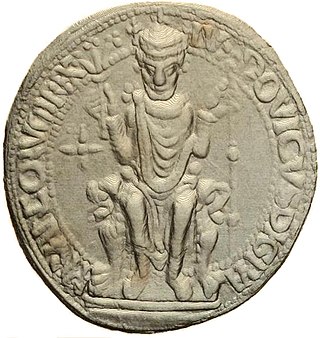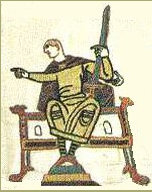
Gisèle of France (also known as Gisela and Gisla) (c. 968 – 1002) was the daughter of Hugh Capet and Adelaide of Aquitaine. [1]

Gisèle of France (also known as Gisela and Gisla) (c. 968 – 1002) was the daughter of Hugh Capet and Adelaide of Aquitaine. [1]
Born around 968-70 as the youngest daughter of Hugh and Adelaide de Aquitaine. Giseles maternal grandparents were , William III, Duke of Aquitaine and Adele of Normandy, daughter of Rollo of Normandy.
Gisele gained the title of princess after her father was elected the new king by an assembly of Frankish magnates at Senlis in 987.
Gisela was married to Count Hugh I of Ponthieu around 994. [1] After her marriage she held the title Dame d'Abbeville as that was one of her husbands fiefs.
Gisela's children by Hugh included:

Louis VI, called the Fat or the Fighter, was King of the Franks from 1108 to 1137. Like his father Philip I, Louis made a lasting contribution to centralizing the institutions of royal power. He spent much of his twenty-nine-year reign fighting either the "robber barons" who plagued the Ile de France or Henry I of England for his continental possession of Normandy. Nonetheless, Louis VI managed to reinforce his power considerably, often resorting to force to bring lawless knights to justice, and was the first member of the house of Capet to issue ordonnances applying to the whole of the kingdom of France.

Rudolph, sometimes called Ralph, was the king of France from 923 until his death in 936. He was elected to succeed his father-in-law, Robert I, and spent much of his reign defending his realm from Viking raids.
William III, called Towhead from the colour of his hair, was the "Count of the Duchy of Aquitaine" from 959 and Duke of Aquitaine from 962 to his death. He was also the Count of Poitou from 935 and Count of Auvergne from 950. The primary sources for his reign are Ademar of Chabannes, Dudo of Saint-Quentin, and William of Jumièges.
William IV, called Fierebras, was the Duke of Aquitaine and Count of Poitou from 963 to his retirement in 990.
The County of Aumale, later elevated to a duchy, was a medieval fief in Normandy, disputed between France and England during parts of the Hundred Years' War.

Adbelahide, Adele, Adela or Adelaide of Aquitaine, was Queen of France by marriage to Hugh Capet, King of the Franks. Adelaide and Hugh were the founders of the Capetian dynasty of France, which would rule France until the 18th and 19th centuries. As queen consort, Adelaide had some extent of influence over her husband's governance of France. Adelaide is typically only briefly mentioned in connection to her husband, Hugh, and her son Robert II.

William III of Ponthieu also called William Talvas. He was seigneur de Montgomery in Normandy and Count of Ponthieu.
Adelaide of Normandy was the ruling Countess of Aumale in her own right in 1069–1087. She was the sister of William the Conqueror.

Guy I of Ponthieu was born sometime in the mid- to late 1020s and died 13 October 1100. He succeeded his brother Enguerrand II as Count of Ponthieu.
Agnes of Ponthieu was ruling Countess of Ponthieu from 1100.
Enguerrand II was the son of Hugh II count of Ponthieu. He assumed the county upon the death of his father on November 20, 1052.
Hugh II of Ponthieu was count of Ponthieu and lord of Abbeville, the son of Enguerrand I of Ponthieu. Evidently, Hugh II was the half-brother of Guy, who became the bishop of Amiens; Fulk, who became the abbot of Forest l'Abbaye; and Robert. However, it is possible that both Robert and Hugh II were the sons of Enguerrand's first wife, and Guy and Fulk the sons of a later wife that Enguerrand I married when he was in his forties.
Enguerrand I was the son of Hugh I of Ponthieu and Gisela, daughter of Hugh Capet.
Hugh I of Ponthieu, who died circa 1000, was also known as Hugo Miles.
Guy II of Ponthieu was the son of William III of Ponthieu and Helie of Burgundy.

The County of Ponthieu, centered on the mouth of the Somme, became a member of the Norman group of vassal states when Count Guy submitted to William the Conqueror, Duke of Normandy after the battle of Mortemer. It eventually formed part of the dowry of Eleanor of Castile and passed to the English crown. Much fought-over in the Hundred Years' War, it eventually passed to the French royal domain, and the title Count of Ponthieu became a courtesy title for the royal family.

Joan of Dammartin was Queen of Castile and León by marriage to Ferdinand III of Castile. She also ruled as Countess of Ponthieu (1251–1279) and Aumale (1237–1279). Her daughter, the English queen Eleanor of Castile, was her successor in Ponthieu. Ferdinand II, Count of Aumale, her son and co-ruler in Aumale, predeceased her, thus she was succeeded by her grandson John I, Count of Aumale.
Hedwig of France, also called Avoise, Hadevide or Haltude, was Countess of Mons. She was the daughter of Hugh Capet, the first Capetian king of France, and his wife, Adelaide of Aquitaine.

The Battle of Mortemer was a defeat for Henry I of France when he led an army against his vassal, William the Bastard, Duke of Normandy in 1054. William was eventually to become known as William the Conqueror after his successful invasion and conquest of England.

The Montgomery family or de Montgomerie is a prominent family of Anglo-Norman origin, belonging to both French and British nobility. At the turn of the 12th century, the family was one of the leading families, with Robert de Bellême being the wealthiest and most powerful magnate in England and Normandy. The House was succeeded by the House of Belleme.